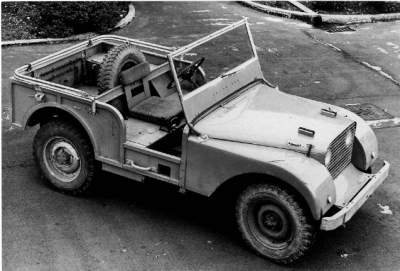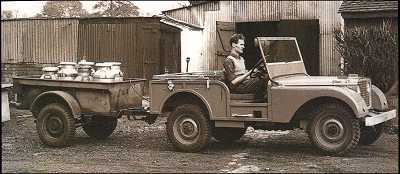

 |
The Land Rover was designed by the Wilks brothers (at that time Rover was owned by the Wilks family) who had a farm in Anglesey where they drove around in their WW2 Willys Jeep. The very first prototype still had a lot of "borrowed" parts but in the real production they were replaced by british ones. The center steering was still a testimony to the agricultural tractors and was intended to eliminate the need to produce left- and right-hand steering vehicles for different markets. |
 |
A good idea but it proved impractical in real world so it was dropped on later vehicles. The chassis of the first prototype was an Willys chassis, but on the first pilot-production vehicles it was already made of 4 flat iron plates welded together thus elininating the need for expensive jiggs. For similar reasons the panels were made of flat aluminium (iron was still short). The vehicle was thought of as a stop-gap to overcome the hard time until steel would be available again and Rover could go back into car building. Laws at that time forced a certain amount of production to be exported to regain economical strenght and the cars simply were not desired elsewhere in sufficient numbers. |
Some datas. Sadly only a few pictures remain at the British Motor Industry Heritage Trust.
The chassis was from a Willys Jeep, with a redesigned front bumper. Same for the axles, military wheels and U-shaped spring shacles. Logic dictates that springs, shock absorbers and brakes were also Willys. The experts agree that transfer box, driveshafts and handbrake assembly come from the same source and brochures from that time seem to confirm this. Pure Jeep were the hood stick and clamp brackets.
Rover provided engine, clutch and gearbox. They used the 1389 cc engine from the 10hp saloon.
The driver position was moved forward 3", the seats replaced, the beginning of a bulkhead appeared as well as a seat box and the doorways squared off. On later vehicles the windscren an seat box were moved forward another 3", making for a 37" loadbay compared to the Willys 31". The outer framework on the body panels was probably used to stiffen the soft aluminium panels. A nice side effect was the smooth interior.
It was painted grenn, Aircraft Cockpit Green, which was plenty at that time.
A determined man, Paul Reinge, is reconstructing this prototype. Hopefully the reconstructed prototype will be on display soon.